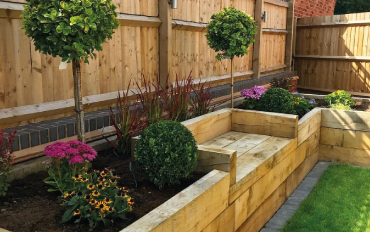How To Stop Garden Bed Sleeper Shrinkage

Raised beds are an ideal way to grow a wide variety of plants, fruits and vegetables. They are excellent at improving drainage, increasing soil temperature, growing plants in a different soil type, enhancing root health and improving ease of access and management, particularly if you have restricted mobility as they reduce the need to bend.
You can grow almost any plants in raised beds and they can be built at any time, with little tools required. When building a raised bed, it is important to consider:
• How big your raised bed needs to be and where you need it;
• Which railway sleepers and tools are most suitable for the job at-hand; and
• Which soil type is best for the plants, fruits or vegetables you are looking to grow.
Throughout this easy-to-follow guide, we will talk through the above points to help you construct a raised plant bed.
These instructions demonstrate how to build a 2-layer, 8x4 foot raised bed, using the following:
• 4 x 2.4m Timber Sleepers
• 4 x 1.2m Timber Sleepers
• 16 x 150mm Timber Screws
• 8 x 250mm Timber Screws
• 1 x Hex Driver Bit
• Weed Control Fabric
• Compost / Growing Media
1. Choose the right timber sleepers for your raised garden bed
There are various types of railway sleepers and each have their own set of characteristics, making them ideal for different jobs and garden aesthetics. When building a raised bed, we would recommend new sleepers over reclaimed sleepers, as these not only blend well into most garden designs, but they are also easier to cut, stack and secure. If a rustic look is preferred, our charred brushwood sleepers are a great option, as they have a similar patina to reclaimed sleepers, but are easier to use and stack as they have straight edges.
Another consideration to make is whether to build your raised bed using pressure-treated (also called 'tanalised') softwood sleepers or untreated hardwood oak sleepers. With oak being a hardwood, it is a naturally dense timber, meaning oak sleepers do not require treating with a preservative and are typically more resilient than softwood. However, as oak sleepers are heavier than softwood, it can make the construction more difficult. Softwood is generally a more affordable option than oak sleepers and once tanalised, will have long-lasting protection against damp and rot, making both oak and softwood sleepers a great option for raised beds. You can view our full range of sleepers here.
2. Choose the size and position of your raised bed
Depending on the size of your garden or allotment and what you are looking to grow, will depend on the size and position of your raised bed. If you are building more than one raised bed, it is important to consider your access requirements between the beds, such as making them wide enough to wheel a barrow or accommodate special needs such as wheelchairs. As a general rule, 30cm (1ft) is the minimum width suitable for walking and 45cm (18in) is the minimum width for wheelbarrows.
3. Lay the sleepers on the ground and fasten them together
To begin constructing your raised bed, lay 2 x 1.2m sleepers and 2 x 2.4m sleepers on a level section of ground in a rectangular shape, with the narrowest sides on the ground and facing upwards. Many people lay sleepers down directly on the earth, grass or concrete, however, some landscapers will often consider a foundation of concrete or hardcore. Next, use two 150mm timber screws at each corner to attach the sleepers together. 50mm of the length of the screw needs to drill into the adjoining sleeper to create a solid connection.
4. Add another layer to the raised bed
Now you have secured your first layer, it is time to add a second layer so that the raised bed is deeper from the ground. Some people may choose to stop at one layer, however, a 2-layer raised bed is often the preferred choice. To create the second layer, we recommend individually laying each of the sleepers on top of the box you have created, overlapping the joins as if you are bricklaying. Create one corner and screw these together before adding the remaining sleepers to create the same rectangular shape.
Next, attach the layers together using 250mm timber screws, drilling down from the top to secure the two layers together.
If you want more layers, simply repeat this stage until you have achieved your desired height.
5. Attach a plastic membrane to the raised bed
Some gardeners and landscapers choose to fix a plastic membrane on the inside of the raised bed, to create a barrier between the wet soil and the railway sleeper. If you are positioning the raised bed directly to the ground, we recommend using weed control fabric to suppress weed growth without the need for harsh chemicals.
6. Fill your raised bed with soil and add your choice of plants
Before you fill your raised bed with compost, topsoil or manure, it is worth considering placing cobbles or hardcore at the bottom of the bed to improve drainage.
One of the many benefits in using raised beds is that you can fill them with the soil that best matches your planting. By filling raised beds with ericaceous compost, for example, lime-hating plants can be grown even where the underlying soil is alkaline. We supply a wide range of compost and growing media, in both standard bags and 800kg bulk bags here.
TOP TIP: To improve moisture in the bed, apply a top surface such as a bark mulch or slate chippings.
How To Stop Garden Bed Sleeper Shrinkage
Source: https://www.sure-green.com/blog/how-to-build-a-raised-garden-bed-with-timber-railway-sleepers.html
Posted by: hortonsomint1948.blogspot.com

0 Response to "How To Stop Garden Bed Sleeper Shrinkage"
Post a Comment